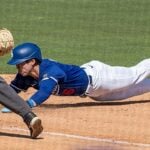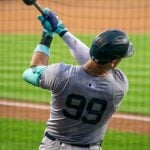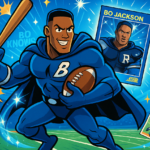Last Updated on October 1, 2024 by Matt Musico
As we’ve been working through our team-by-team single-season home run leaderboards, there have been occasions where one player dominates most of our digital ink. It’s happened for teams like the Yankees, Giants, and Mariners, to name a few. But has there been a team that has one player dominate their leaderboard as much as the single-season Twins home run leaders?
I’m not so sure. Based on what Harmon Killebrew did during his time with the organization, it wouldn’t be outrageous for a petition to get started to rename them the Minnesota Killebrews.
OK, that’s probably a little extreme, but still, just look below and you’ll see what I mean. This man has each of the top six most powerful seasons in Twins history, eight of the top 10, and nine of the top 15. Let’s dig into some of the details.
Related: A Complete Guide to Single-Season (& Single-Game) HR Performances
Twins Home Run Leaders
Harmon Killebrew

Based on how often he appears here, it’s not a surprise that Killebrew not only holds the Twins’ single-season home run record but is also the franchise’s all-time home run leader. Although the legendary slugger never officially recorded a 50-homer season, he did surpass 40 eight (!) times.
Here are his eight seasons that appear in the top 10:
- 49 homers in 1964 and 1969
- 48 homers in 1962
- 46 homers in 1961
- 45 homers in 1963
- 44 homers in 1967
- 42 homers in 1959
- 41 homers in 1970
Believe it or not, a whopping three of these performances are single-season franchise records at different positions.
There were a couple of occasions when Killebrew didn’t slug at least 40 home runs in a season between 1959 and 1970. Despite that, his season-long averages during this stretch are just incredible. During these 12 seasons, Killebrew slashed .265/.386/.543 while averaging 40 homers, 103 RBI, and 88 runs scored.
Averaged! From his age-23 to his age-34 campaigns! That’s longevity personified if I’ve ever seen it.
After several close calls, Killebrew captured that elusive MVP award in 1969 when he led the league in homers (49) and RBI (140). Through the end of June, the right-handed hitter had 18 homers and 54 RBI. From July through the end of the season, he slugged 31 homers with 70 RBI.
Brian Dozier
Brian Dozier’s 2016 campaign was notable for several reasons. One of them was because we don’t see many 40-homer campaigns from second basemen. Another was it’s very rare to see someone hit that many dingers in a Twins uniform not named Harmon Killebrew.
Dozier also drove in 99 runs, making this the first of two straight years where he went 30-30-90-100 (homers, doubles, RBI, runs scored). He finished 13th in AL MVP voting but didn’t get selected to appear in the All-Star Game. That may make some scratch their head, but it’s because the majority of his work happened in the second half.
Whenever I think of Dozier’s 2016 performance, what he did down the stretch is the first thing that comes to mind. Through his first 359 plate appearances, he owned a .786 OPS with 14 home runs and 43 RBI. But over his final 332 trips to the plate, Dozier posted a .990 OPS while doubling his homer output with 28 dingers and adding 56 RBI for good measure.
He only had five homers and 17 RBI through the end of May, so he went to work after that. Dozier saved his best work for last, as he combined to hit 23 homers in August and September alone, reaching double digits in each month.
Roy Sievers

Before Killebrew began dominating the Twins’ single-season home run leaderboard, Roy Sievers was the home run king. He slugged 42 homers in 1957, which led the league in that category, as did his 114 RBI. This was easily the apex of Sievers’ power, but it was right in the middle of a nine-year stretch where he slugged at least 20 per season.
Sievers paired those power numbers with a solid .301/.388/.579 line, which helped him earn a trip to the All-Star Game, along with finishing third in AL MVP voting.
His OPS between home (.988) and away (.943) games weren’t much different, but he had a clear preference when it came to hitting his dingers. Of the 42 he hit in 1957, 26 came in front of the home crowd, while the other 16 happened on the road. He also never had a month with double-digit homers, but he got more consistent in the second half.
Through the first three months, he hit at least seven dingers once (eight in June). Over the final three months, he met or surpassed that number each time (nine in July, seven in August, eight in September).
Nelson Cruz
For someone who collected an inside-the-park home run as one of his first big-league round-trippers, it was fascinating to watch Nelson Cruz’s late-career power surge.
It started in 2014 when he led the American League in home runs with a then-career-high of 40 for the Baltimore Orioles, and it’s just continued from there. After a powerful four-year stint with the Mariners, he landed with the Twins. His only full season in Minnesota was in 2019, and he made it count with another 41 homers. This made Cruz just the third player in Twins history not named Killebrew to reach that number.
Of all the great seasons Cruz has put together in his career, 2019 involved his best triple slash. It was .311/.392/.639, which yielded a single-season career-high 1.031 OPS. He received a similar number of plate appearances in the first and second half, but the slugger saved his best work for the end. Before the All-Star Game, he owned a .921 OPS with 16 homers and 46 RBI. After the midsummer classic, those numbers increased to 1.148, 25, and 62, respectively.
Twins Home Run Leaders: The Rest
Here’s what the rest of the Twins’ top-21 most powerful seasons in franchise history look like:
- Harmon Killebrew, 1966: 39 home runs
- Roy Sievers, 1958: 39
- Jim Lemon, 1960: 38
- Max Kepler, 2019: 36
- Bob Allison, 1963: 35
- Josh Willingham, 2012: 35
- Brian Dozier, 2018: 34
- Gary Gaetti, 1986: 34
- Kent Hrbek, 1987: 34
- Justin Morneau, 2006: 34
Find out who is on the outside looking in by taking a peek at the rest of this list at FanGraphs.
Frequently Asked Questions
What Minnesota Twins player has the most home runs?
Harmon Killebrew’s 559 home runs are the most in Twins history.
What year did the Twins break the home run record?
The Twins hit 307 home runs as a team in 2019, which is the current MLB record.
Which Minnesota Twins player has the most home runs in a season?
Harmon Killebrew is the Twins’ single-season home run king. He slugged 49 home runs in 1964 and 1969.
Want to see the Twins slug dingers in person? Grab tickets from our friends at Vivid Seats. And before you get to the stadium, make sure you’re decked out in the right gear. Get official Twins merch from the MLB Shop or a ‘Big Dinger Energy’ shirt from our apparel store.





Leave a Reply